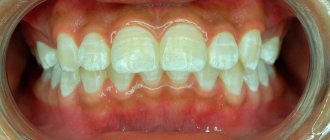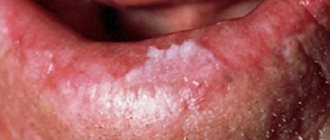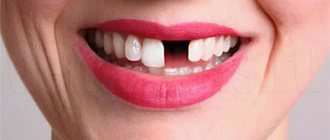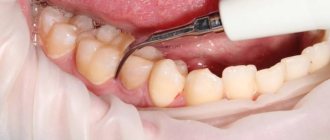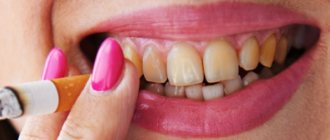A snow-white smile today is considered a mandatory attribute of beautiful appearance. Therefore, when black spots appear on the teeth, there is a desire to get rid of them as soon as possible. But first you need to understand the reason for the appearance of blackheads. Why the enamel darkens, whether it could be caries, we will tell you in the article.
In this article
- Is a black dot on a tooth a caries?
- What is black caries?
- Spots on teeth due to fluorosis
- What to do if large or small spots appear on your teeth?
- How to treat caries in the form of spots on teeth?
- Prevention of caries and dark spots on teeth
Is a black dot on a tooth a caries?
There is a widespread belief that black spots on teeth are always caries. A dental disease that begins with the loss of mineral substances by the enamel and is accompanied by the gradual destruction of hard tooth tissues. Indeed, stains on a tooth can be signs of early caries. But this is only one of the possible reasons.
Various factors can lead to a change in enamel color:
- Poor oral hygiene, improper brushing of teeth, resulting in the formation of plaque and tartar on the enamel surface, which leads to the destruction of the tooth structure.
- Regular consumption of coloring foods and drinks, in particular coffee, black tea, Coca-Cola. They stain the enamel, which leads to its darkening.
- Smoking. The tars contained in cigarette smoke settle on the tooth enamel, resulting in a dark stain of plaque that cannot be removed even with daily brushing.
- Diseases of the gastrointestinal tract disrupt the acid balance in the oral cavity. Because of this, the enamel loses strength, becomes more sensitive and darkens.
- Black spots may be associated with wearing braces and dentures. In this case, dark spots form in areas of contact with orthodontic structures due to metal oxidation, poor hygiene or an allergic reaction.
- Another cause of dark spots on teeth is erosion of tooth enamel, which, contrary to popular belief, is not associated with tooth decay. This dental pathology must be treated. Without treatment, the black spot grows, the enamel is gradually worn away, and erosion affects the deeper layers of the tooth.
- Injury. With a strong blow to the front teeth, the pulp tissue - the neurovascular bundle - can be torn and injured. As a result, a hematoma forms, which causes the tooth to turn black.
- Other reasons. Less commonly, the appearance of black spots and stains on teeth is due to prolonged use of medications, weakened immunity, and hormonal imbalance.
Only a dentist can determine why black spots appear on the teeth, whether they are caries or not. Therefore, for any darkening of the enamel, be sure to consult a specialist.
Why do children's teeth turn black?
Adults, as a rule, react ambiguously to black teeth in children. Some people perceive this color change as a sign of caries and do not consider it necessary to contact the dentist. They are simply convinced that it is not necessary to treat baby teeth. Others are sincerely surprised that the child’s teeth have turned black, try to find the reason for this and come to the pediatric dentist for an answer. Of course, we support the opinion of concerned parents, because the health of permanent teeth depends entirely on the condition of milk teeth.
So why are teeth black? If you notice black lines on your child’s teeth almost right next to the gums, then they may be caused by Priestley’s plaque. It appears due to age-related changes in the digestive system. Once this process is complete, such plaque usually simply disappears. However, you must come to the dentist for an examination.
But the main reason for black plaque or spots on teeth is eating large amounts of sweets and starchy foods. Together with poor hygiene - and children very rarely brush their teeth well - poor nutrition becomes a catalyst for the appearance of a dense microbial film (usual pigmented plaque) and caries. Therefore, it is very important for parents to monitor not only the hygiene of the child, but also his nutrition.
However, children may have black teeth not only because of Priestley’s plaque, poor hygiene and an abundance of sweets. Here are some other reasons for the color change:
- caries
- problems with the gastrointestinal tract
- lack of calcium
- genetic predisposition
If your child's baby teeth are black or have dark spots, stains, or plaque on them, be sure to visit your pediatric dentist. It is very important to find out the cause of the changes and return your smile to a healthy color.
What is black caries?
There is no such term as black caries in dentistry. But among ordinary people this is the name given to the stage of the carious process at which the teeth darken. How does this happen?
“Black caries” may be at the initial stage. In this case, first white and then black dots form on the surface of the enamel - areas of demineralization. In these places, the enamel is thinned and vulnerable to the damaging effects of acid. If you do not pay attention to the blackheads in time and do not treat them, then the caries will go deeper and spread to the dentin.
Sometimes “black caries” is a carious lesion in which a hole has already formed in the tooth. Bacteria produce organic acids and gases, which not only destroy the structure of tissues, but also stain them. With caries, black spots can even show through tooth enamel.
Preventive measures
The main condition for reducing the risk of dental diseases is maintaining oral hygiene.
Other factors that can trigger the appearance of fissures include:
| Presence of injuries to teeth and gums | In addition to pronounced damage, there are also invisible ones that appear due to bad habits (picking teeth with hard objects, etc.). Such actions leave microdamages on the enamel and gums, in which infections can form, and in the future lead to more serious diseases. Therefore, monitor the condition of your teeth and gums. |
| Rare visits to the dentist | Caries and other diseases develop gradually. Fissures are just one of the symptoms of damage. The disease should be dealt with in a timely manner, and not in the later stages. Get checked regularly by doctors, optimally at least 2 times a year. This will help identify caries at an early stage, when it is easier (and cheaper) to fight it. |
Spots on teeth due to fluorosis
It is generally accepted that fluoride is a microelement beneficial for teeth, because it strengthens tooth enamel, increases its protective properties, and prevents the leaching of calcium. But with an excess of fluoride in the body, a disease such as fluorosis can develop. It causes destructive changes in the hard tissues of teeth. Fluorosis is typical for residents of regions where drinking water is fluoridated, as well as for those who constantly brush their teeth with fluoride paste and eat a lot of fluoridated foods. One of the most striking signs of the disease are spots on the enamel. At first they are light, but as the pathology develops they become yellow or dark brown.
Teeth with fluorosis lose strength, chewing surfaces quickly wear away, chips and areas of erosion may appear, and sometimes the disease leads to complete destruction of the dental crown. The choice of treatment method depends on the degree of tooth decay.
Prevention measures
Unfortunately, it is impossible to completely prevent the risk of developing caries between teeth. However, there are a number of simple preventive measures that will significantly reduce the likelihood of infection:
- - maintaining proper daily oral hygiene with the help of a properly selected toothbrush and paste;
- - using dental floss to clean interdental spaces;
- — use of irrigators;
- — refusal to use wooden and other types of toothpicks;
- - limiting sweets in the diet, especially sticky and stretchy foods;
- - visiting the dentist every six months for the purpose of prevention (oral sonation).
A comprehensive examination and effective painless treatment of interdental caries is carried out by the dental studio of Leonid Gorbunov in St. Petersburg. We employ experienced specialists and have modern equipment and materials to eliminate caries of any complexity. Make an appointment by phone or through the feedback form.
Posted by:
What to do if large or small spots appear on your teeth?
Any changes in the color or structure of tooth enamel are a reason to be wary and seek advice from a dentist. Only a doctor, after diagnosis, will be able to accurately answer the question: is a blackhead a symptom of caries? Or the darkening occurred for another reason.
If a stain on the front teeth occurs as a result of a bruise, the dentist will remove the affected tissue, process and fill the canals, and, if necessary, recommend installing veneers or endo-whitening (lightening the tooth from the inside).
If the cause of dark spots is poor hygiene or poor plaque removal, professional cleaning using ultrasound or laser will help solve the problem. These methods are good at removing plaque and tartar from the enamel surface and returning the teeth to their natural shade.
If food coloring is the cause of teeth staining, professional hygiene combined with a subsequent whitening procedure can help.
Unfortunately, dark spots on teeth are caries in the vast majority of cases, and the carious process at any stage requires immediate treatment.
Dental methods
Before prescribing a treatment method, the doctor asks the patient:
- At first, the dentist removes soft plaque and eliminates caries
His lifestyle, approximate diet, bad habits.
- Existing diseases (especially chronic ones) and medications consumed.
At first, the dentist removes soft plaque and eliminates caries.
The patient may be referred for:
- X-rays.
- Methylene indicator.
- Illumination of the affected areas with a powerful beam of light.
If the doctor suspects that the reason for the appearance of the fissure is in internal pathologies (when the oral cavity has been cleansed of dirt and pigments), the patient needs to undergo additional tests and be examined by:
- Gastroenterologist.
- Endocrinologist.
After all the tests, a suitable method of dealing with dark spots is prescribed.
Ultrasonic cleaning
A universal method used to eliminate many aesthetic defects on incisors
Ultrasonic cleaning is a universal method used to eliminate many aesthetic defects on incisors.
Fissures disappear under the influence of a special device that emits vibration waves.
The procedure is painless, but also has a number of contraindications:
- Cardiac arrhythmia.
- Presence of colds.
- Increased sensitivity of teeth.
- Severe diseases of the immune system and liver.
- Installed implants and orthopedic structures implanted in the oral cavity.
Air Flow
The technique is safe and gives results in the fight against dental plaque and fissures.
This method, developed by Swiss specialists, is based on the use of soda, air and water, which are applied under high pressure to areas of tooth enamel.
The technique is safe and gives results in the fight against dental plaque and fissures.
But there are exceptions.
Air Flow is not prescribed for those patients who:
- There are inflammatory processes in the oral cavity.
- There is severe diabetes mellitus.
- Asthma, epilepsy, hepatitis (and other severe viral diseases) were detected.
Laser whitening
Long-lasting effect after using laser, which keeps teeth clean for the next 5 years
Laser whitening differs from the above methods in the higher cost of the procedure.
But the method has before them, the main one is the long-lasting effect after using the laser, which keeps the tooth clean for the next 5 years.
Whitening is carried out using special equipment, and the effect on the areas itself does not harm the enamel of the teeth and does not lead to bleeding gums.
How to treat caries in the form of spots on teeth?
Dental caries goes through several stages. First, a light spot appears on the enamel, which is sometimes even difficult to notice. Then it becomes rough and darkens. If the process is not stopped, the destruction continues further, and a cavity forms in the enamel. At the stage of medium and deep caries, the cavity affects the dentin and gradually expands.
Caries in the form of a dark spot is one of the early stages of carious lesions. Bacteria penetrate into areas of demineralized enamel, producing acid and gas, which stain the enamel dark. At this stage, you can still do without a drill if caries is diagnosed in time.
There are several methods for treating caries in the dark spot stage.
- Remotherapy.
Another name for the method is remineralization. Its essence is to restore the normal mineral composition of the enamel, saturating it with calcium and phosphorus ions. These minerals are delivered to the teeth using pastes, gels, and special compounds that are applied to the surface of the enamel.
- Fluoridation.
Another option for strengthening teeth at the stage of black carious spots is to saturate dental tissues with fluoride. The enamel is coated with gel or fluoride varnish. With simple fluoridation, the drug contains exclusively fluorides, with deep fluoridation - additional minerals, such as calcium.
- ICON method.
This method of treating caries in the form of a black spot has appeared relatively recently. Its essence is that after preliminary treatment and preparation of the tooth, it is coated with a special sealant that seals the enamel pores, preventing bacteria from penetrating deep into the tooth and destroying dentin. The method is safe and painless, suitable for adults and children. But for such treatment it is important to sit for 20 minutes without moving. Therefore, ICON is not prescribed to children under three years of age who find it difficult to sit still for that long.
- Preparation and filling.
Sometimes a carious cavity is hidden behind a small black dot. If during diagnosis the dentist discovers a hole in the tooth, then it will have to be treated surgically using a drill. First, the tooth will be numbed with a modern anesthetic, then areas of dental tissue affected by caries will be removed, the cavity will be treated with antiseptic, medicinal solutions, and an adhesive composition will be applied to the walls for better attachment of the filling material. After this, the prepared cavity is filled with a special composite. Today, light-curing fillings are predominantly used, which harden under the influence of light, last for many years and do not shrink. At the final stage, the dentist will align the tooth according to the bite, grind and polish it.
Methods for diagnosing contact caries
Visual inspection.
It is carried out during an appointment with the dentist. An old, traditional, cost-free method. But less accurate, because In some places, the dentist may not notice the early stages of caries development.
Diagnodent device
. Detection of lesions occurs by emitting special sound waves, which, reflecting from carious areas, are captured by the device. A very accurate diagnostic method.
X-ray diagnostics.
An excellent diagnostic method, because... allows you to identify carious lesions at an early stage at any location.
Prevention of caries and dark spots on teeth
In most cases, darkening of the enamel can be prevented by following simple preventive measures.
- Brush your teeth regularly and correctly.
Clean the surface of your teeth, gums, and tongue from plaque at least twice a day using a therapeutic and prophylactic paste that is appropriate for the age and condition of your teeth. Do not use fluoride toothpaste without a doctor's recommendation to avoid fluorosis. To clean brace systems, purchase special brushes that will ensure high-quality removal of food debris and other contaminants in the areas where the braces adhere to the teeth. Use dental floss, irrigator, and mouth rinses to clean all hard-to-reach areas.
- For preventative purposes, visit the dentist twice a year.
Any dental problems, including dark spots, can be treated much easier and faster if they are detected at an early stage. Teeth affected by caries in the form of a small point are in some cases treated using non-invasive methods - without drilling or filling.
- Professional cleaning twice a year.
Once every six months, carry out ultrasonic or laser teeth cleaning to remove complex deposits.
- Rejection of bad habits.
If possible, reduce the consumption of coffee, tea, Coca-Cola, and stop smoking. This will have a beneficial effect on the appearance and condition of your teeth.
Home methods
Baking soda and hydrogen peroxide will not work to get rid of fissures. To do this, dentists use fine toothpaste and carry out whitening with a special hard brush. The patient can only maintain hygiene and review his diet.
Taking vitamins and minerals
The diet should also contain more raw vegetables and fruits, which must be chewed for a long time.
Teeth also need useful substances, the receipt of which helps maintain their normal condition.
Deficiency of vitamins and minerals can lead to:
- Damage to the gums.
- Weakening of the enamel.
This can later lead to tooth decay.
The conclusion is simple: increase the amount of vitamins and microelements consumed, making allowances for special periods (adolescence, pregnancy, recovery from illness, etc.), during which it is advisable to drink a specially selected vitamin and mineral complex.
The diet should also contain more raw vegetables and fruits, which must be chewed for a long time. Thanks to this, blood flows better to the jaw, and the soft plaque that accumulates when consuming soft, refined food is removed.
You will need to reduce your intake of sugar (sweet foods in general): it disrupts the acidity in the mouth, which makes it easier for harmful bacteria to grow. Avoid eating too hot or cold food or drinks.
Special hygiene
During treatment you will need:
- Use conditioner balms.
- Visit the dentist more often, who will monitor changes in the condition of the affected area.
- Brush your teeth after every meal, which will prevent pigments and particles from accumulating inside the oral cavity.
Interdental caries therapy
Treatment of carious cavities occurs under local anesthesia, since the therapy has some complexity, due to the fact that in the absence of carious lesions on the surface of the chewing teeth, it will be quite difficult to approach the carious defect, since drilling of teeth affected by caries is required.
In order to get closer to the tissues destroyed by caries, it is necessary to drill through healthy teeth located above the carious defect. Therefore, in addition to the main goal of treatment - to eliminate the carious defect by excision of the affected tissue and installation of a filling, the dentist needs to do the following:
- Since to remove caries the dentist has to drill into the healthy surface of the tooth, after installing the filling it is necessary to restore the chewing surface of the teeth (restoring the contact of the teeth, cusps, fissures, etc.)
- After eliminating carious defects, the teeth lose tight contact with each other, which can cause food debris to get stuck, leading to a relapse of the disease. Therefore, the dentist needs to restore the required distance between the teeth, for this wedges and matrices are used.
It is worth considering that not all dentists are able to correctly and efficiently carry out therapeutic actions to eliminate caries in the interdental space, so it is necessary to be more demanding in choosing a dental clinic.
Common reasons
Darkening of teeth can look different:
- If the discoloration is caused by plaque that is not properly removed, the color of the dentition appears uneven, darker at the base and lighter towards the edges; Possible causes are abuse of coffee and tea (strongly brewed drinks have a powerful coloring effect) and smoking. It is very difficult for tea, coffee and nicotine lovers to maintain a snow-white smile; they practically have to choose between beautiful teeth and established habits.
- If one or more teeth have a pronounced color difference, we have to talk about poor-quality canal treatment or the development of secondary caries (after removal of the nerve, the darkening of the tooth is explained by the lack of nutrition and is natural; a dark rim around the filling is a signal for its immediate replacement due to a violation of the tightness ). A tooth can also be darkened by trauma that causes nerve death or internal bleeding; whiteness can only be restored through careful treatment of the canals, sometimes with intracanal bleaching.
Black plaque is not only a death sentence for a smile, but also a possible cause of caries. Only regular visits to the dentist will help you avoid troubles and keep your teeth healthy and white.
What is the prevention of plaque formation?
The first step is to completely abandon the harmful habit of smoking and frequent consumption of drinks that form black plaque on the teeth. It is imperative to diversify your diet with solid foods and fiber-rich vegetables, fruits, and cereals. Chewing such food thoroughly helps to naturally cleanse tooth enamel. Timely and properly organized hygienic care of the oral cavity is the basis for preventing the occurrence of plaque on teeth. In addition, do not forget to visit the dentist regularly, even if nothing bothers you.
So, as soon as a specialist can assess the state of plaque and notice problems with teeth in the initial and curable stage. Dental treatment and care requires regularity, strict adherence to specialist recommendations and a professional approach.
